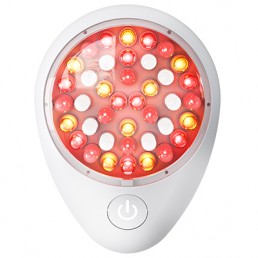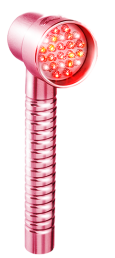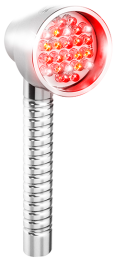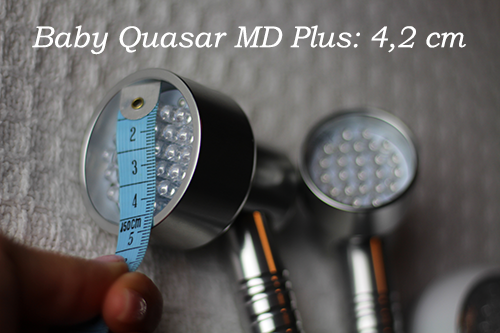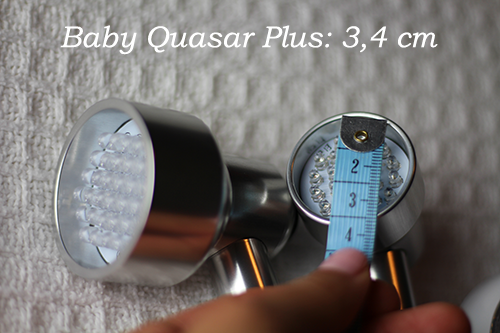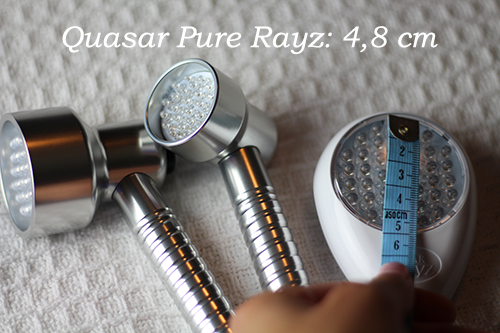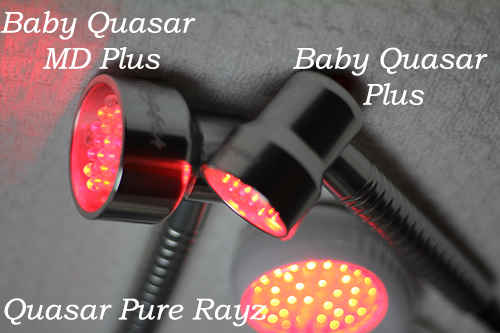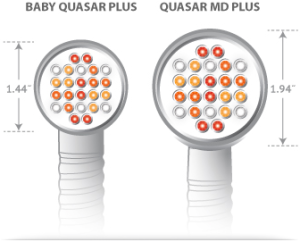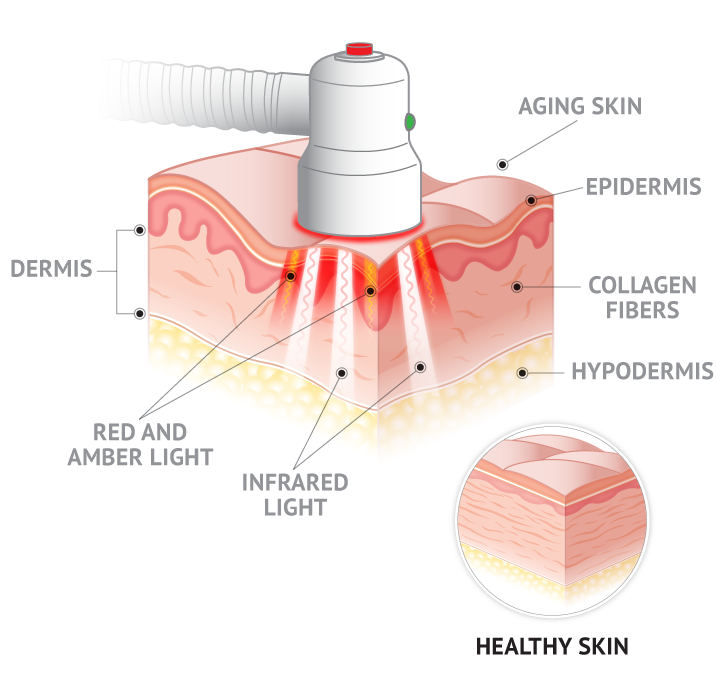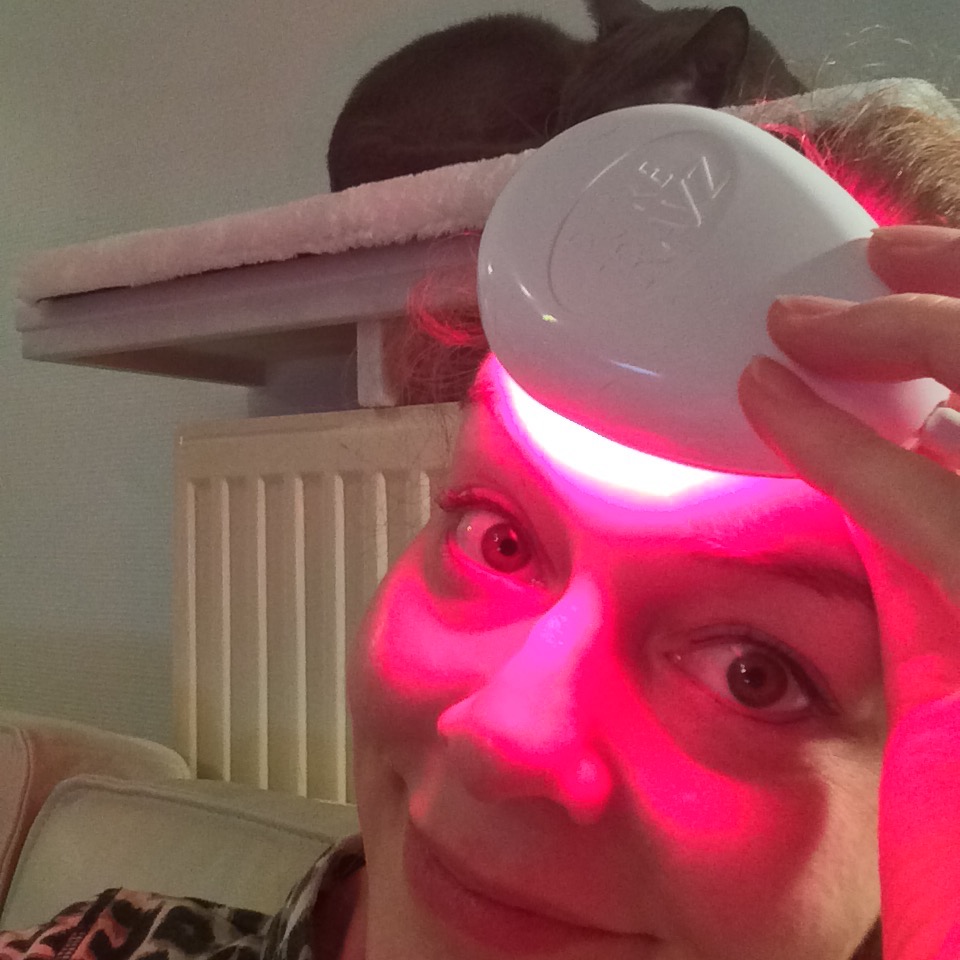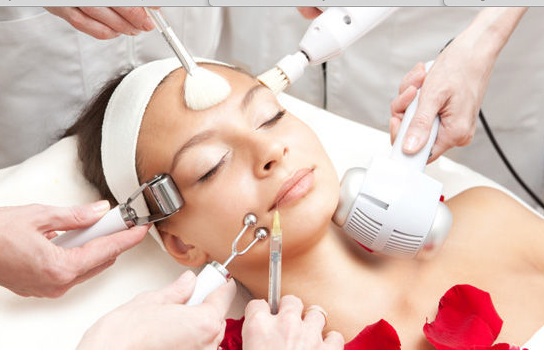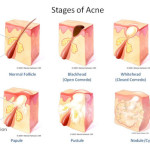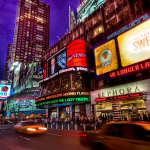Bold claims and promises.
Is Quasar Led therapy a risky investment, or can it actually live up to its claims? The Beauty Test Tube sceptically tested out the Quasar Pure Rayz, the most economic among their different models:
- Quasar Pure Rayz (± €299)
- Baby Quasar (± €399)
- Quasar MD Plus (± €795)
The strength of the LED lights in these 3 Quasar models is the same, but the quality of the aluminium handles is logically higher in the Baby Quasar and Quasar MD Plus, which both have lifetime warrantees, in comparison to the Pure Rayz‘ 5 year warrantee. The Quasar MD Plus does have a larger treatment head than the Baby Quasar Plus though, meaning faster treatment time:
Pure Rayz actually has the largest treatment head of the 3 and contains the most lamps, which compensates for the fact that the Pure Rayz doesn’t have a removable plastic cap like the other models (the plastic has been said to interfere minimally with how the light penetrates the skin).)
Pure Rayz 4 wavelengths of light [610nm (amber), 640nm (red), 660nm (super red) and 850nm (near infrared)] penetrate deeply into the skin, each to a different depth:
The Baby Quasar is the most effective and powerful anti-aging light therapy tool available on the market, with a maximum penetration of light (e.g. much stronger than the Tanda Red). The following video demonstrates this a bit clumsily, but hey, ‘t is true:
https://www.youtube.com/watch?v=InVYELijpqA
Very sceptical about Quasar’s claims, I started using my Pure Rayz in October 2015. Initially I thought of getting the Clear Rayz blue light therapy tool for acne prone skin instead, but Eva Wisse from Freshwater Valley recommended I try the Pure Rayz first, since she told me it also helps with acne and helps heal the skin. The first night I used it, I slept like a baby. Keeping in mind that blue light (emitted by the tv, phone or computer screen) has been proven to worsen insomnia, it seems logical that the soothing warmth of the Pure Rayz tool and the red light it emits may improve sleep (since red light is opposite to blue light, and a bit of extra warmth during cold European winter months can’t hurt). But this isn’t something Quasar claims, it’s just a personal belief. As a psychotherapist who often works with insomnia and recommends avoiding blue light right before bed (or installing f.lux for an improved night’s sleep of die-hard night time laptop users), I do think using the Pure Rayz is at the least a healthier night-time ritual than procrastinating on your phone.
But getting back to business: after just a few uses, I was stunned to find my skin looking so much healthier, glowy and radiant so quickly.
The only con is that it can be a bit drying, but for my oily skin this was more of a pro than a downside, and nothing a good moisturiser couldn’t fix. It also takes quite some dedication and patience, since it’s to be used 5 days a week for 8 weeks, and each treatment takes about 16 minutes (3-4 minutes per zone, with shut-off timer). Again, not a real downside for me, since it’s actually very soothing to use, and it’s become a pleasant evening ritual for me. Ideal to use whilst watching the tele, or as a bed time ritual that’ll probably help you sleep better.
Pulls up/tightens sagging skin:
Baby Quasar and Pure Rayz is supposed to be cel renewing and stimulates blood flow. I was especially sceptical of this cel renewal claim, but I must say my year old facial scar has faded, although this could also be attributed to the passing of time. Nevertheless, I could swear that red post-acne marks (macules) disappear ten times faster.
Cells in the skin and supporting tissue absorb wavelengths between 590 and 950 nanometers. Our cells/tissue convert this light energy into “fuel” that is used to increase cellular metabolism. Research by the National Aeronautics and Space Administration (NASA) has shown that light therapy increases cellular growth up to 200%. *NASA Light-Emitting Diode Technology Brings Relief In Clinical Trials While the NASA study focused on healing injuries, the effect of light therapy on skin is exactly the same. The increased cellular activity stimulates formation of new collagen and elastin — the building blocks of healthy skin.
Even after seeing such results myself, I remained sceptical, thinking the improvement in my skin was a placebo fluke coincidence, so I started some research to see what science had to say about LED (Light-Emitting Diode) therapy. These are 5 conclusions of what I found:
1. Conclusion: Review of the literature revealed that differing wavelengths of light-emitting diode devices have many beneficial effects, including wound healing, acne treatment, sunburn prevention, phototherapy for facial rhytides, and skin rejuvenation. The authors’ clinical experience with a specific yellow light-emitting diode device was mixed, depending on the condition being treated, and was likely influenced by the device parameters. (Light-emitting Diodes: A Brief Review and Clinical Experience: http://www.ncbi.nlm.nih.gov/pubmed/26155326)
The statement confirms that the results shown in the histological analysis of this study, which viewed the reduction of edema and inflammatory response. Also observed, collagen deposition as early as possible in the lesion area, a result which agrees with other authors [11] who claims that the Red LED significantly increases the amount of collagen and elastin by stimulating fibroblasts. (Different Wavelengths of LEDs on Cutaneous Wound Healing in Wistar Rats – Journal of Basic & Applied Sciences, 2015, 11, 389-396)
2. LED photomodulation: A photo-rejuvenation effect using nonthermal stimulation of cells requiring low energy, narrowband light with specific pulse sequence and duration is termed photomodulation , which is one of the recent concepts in acquiring smoother appearance of the epidermis. Here the principle is stimulating very superficial collagen in a nonthermal way. Here light is delivered through light emitting diode (LED) to activate fibroblasts causing them to produce collagen and elastin.[25] This technique is a safe and effective nonpainful non-ablative modality for improvement of photoaging and can be used in all Fitzpatrick skin types without any adverse effect.[26] (Antiaging therapies: Vedamurthy M. Antiaging therapies. Indian J Dermatol Venereol Leprol 2006;72:183-6)
3. LED photomodulation reverses signs of photoagingusing a new nonthermal mechanism. The anti-inflammatorycomponent of LED in combination with the cell regulatory com-ponent helps improve the outcome of other thermal-based reju-venation treatments © 2005 by the American Society for Dermatologic Surgery, Inc.
4. Results:
In LED-treated patients, 18 (94.7%) had grade 0 or 1 reaction and 1 (5.3%) had grade 2 reaction. Among controls, 4 (14.3%) had a grade 1 reaction, 24 (85.7%) had a grade 2 or 3 reaction. One LED-treated patient (5.3%) and 19 controls (67.9%) had to interrupt treatment.Conclusion:
LED photomodulation treatments immediately after IMRT reduces the incidence of NCI grades 1, 2, and 3 skin reactions in patients with breast cancer treated by radiation therapy (RT) postlumpectomy. Lasers Surg. Med. 39:164–168, 2007. © 2007 Wiley-Liss, Inc. http://onlinelibrary.wiley.com/doi/10.1002/lsm.20455/epdf
5. Blue and Red Light Combination LED Phototherapy for Acne Vulgaris in Patients with Skin Phototype IV
Results:
The final mean percentage improvements in non-inflammatory and inflammatory lesions were 34.28% and 77.93%, respectively. Instrumental measurements indicated that the melanin levels significantly decreased after treatment. Brightened skin tone and improved skin texture were spontaneously reported by 14 patients.
Conslusion:
Blue and red light combination LED phototherapy is an effective, safe and non-painful treatment for mild to moderately severe acne vulgaris, particularly for papulopustular acne lesions.
Bryan Barron from the Paula’s Choice research team praises BabyQuasar’s industry leading warrantees and money back guarantees, but they do stress that devices at the dermatologist’s are stronger and more effective:
“As to whether or not these are comparable to what you can get done from a dermatologist, I think you can get a portion of the results but ultimately the procedure that you can have done at a dermatologist’s office or a medical aesthetician’s office, I think, are going to get you better results.”
That seems a bit obvious, doesn’t it? The devices at the dermatologist’s office cost fortunes, and will logically be more powerful (home devices need to remain safe to use at home, after all). What does make me greatly prefer my PureRayz, however, is that it’s an affordable, quality product that you can use indefinitely from the comfort of your lazy sofa. And that, should make it more effective in the long run.
Mr. Barron continues: “(…) they can stimulate cellular energy. And what that means is they work to stimulate the production of a cell-communicating ingredient in the skin called adenosine triphosphate. And when that ingredient is stimulated it in turn talks to fiber blasts in skin and fiber blasts are the cells in skin that make collagen. So the ATP is stimulated by the red light. It gets excited. It goes over the fiber blasts and talks to them saying, “Hey, there is this message I am getting from somewhere outside of the body that says we need to start making better collagen.” And then at the same time, this is what I thought was interesting, is that the red light also seems to destroy damaged collagen and elastin while not harming the healthy collagen and elastin.”
- Netflix and PureRayz.
- “Turn it back on”, screamed the cat.
Either way, my PureRayz has definitely done more for my skin than my dermatologist’s AHA peels or even Genesis laser treatments. And whenever I skip treatment for a couple of days, I actually notice it in my skin, so I’m pretty confident that this device will remain a staple in my skin regime for many days to come.
All in all, I worship my Pure Rayz, and still use it religiously after months of use. Worship and religion strong terms for a beauty device you say? Nay, it’s worthy of its following, and I’m a believer.
Update May 2016: Still in love with my Pure Rayz, and it’s become clearer than ever that it works, since my skin looks noticeably worse as soon as I stop using it for a week or 2.
